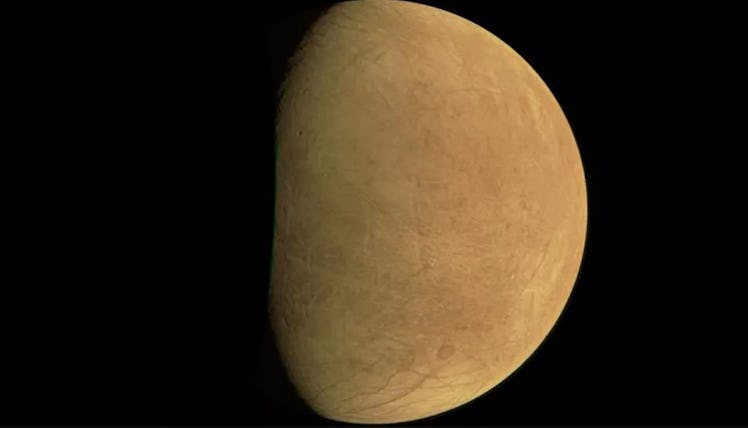NASA Just Released Closest, Most Astounding Photos Of Jupiter's Europa In Decades
The new photos come from NASA’s Juno probe, and the first photos of Jupiter’s Europa have been released.

NASA keeps dropping more photos of incredible, jaw-dropping outer space in views we’ve never seen before. The newest images don’t come from the James Webb Space Telescope, though, which has been giving us wow-worthy images lately. These new photos come from NASA’s Juno probe — and they show the first photos of Jupiter’s Europa in decades.
The Juno probe is part of NASA’s New Frontiers Program and was launched into space in 2011 to get close to Jupiter and learn more about the distant planet. According to NASA, the probe reached its destination in 2016, and the new photos were taken when the probe made its closest pass in 22 years to the icy moon known as Europa.
"Rugged terrain features are easily seen, including tall shadow-casting blocks, while bright and dark ridges and troughs curve across the surface. The oblong pit near the terminator might be a degraded impact crater," JPL officials wrote of Juno's flyby imagery on September 29.
The moon near Jupiter is similar in size to Earth’s moon. However, it has a much different history and formation, per NASA. Europa has a cold crust overtop an ocean that researchers have long thought may be capable of supporting life similar to what we have here on our planet.
In the latest flyby, the Juno probe returned some of the “highest-ever resolutions pictures,” according to Space.com. And scientists were able to get a good look at the atmosphere and environment of the icy moon.
“The science team will be comparing the full set of images obtained by Juno with images from previous missions, looking to see if Europa’s surface features have changed over the past two decades,” said Candy Hansen, a Juno co-investigator who leads planning for the camera at the Planetary Science Institute in Tucson, Arizona. “The JunoCam images will fill in the current geologic map, replacing existing low-resolution coverage of the area.”
During the flyby, the trajectory of the Juno probe was modified a bit to help reduce the time it takes for it to orbit Jupiter. Instead of taking 43 Earth days to orbit, it will only take 38 days, hopefully allowing researchers to continue to get more data on the sixth largest Moon in our solar system.